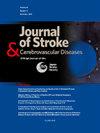饮食炎症指数在体重调整腰围指数与中风之间的中介作用:来自NHANES 2003-2018的见解
IF 1.8
4区 医学
Q3 NEUROSCIENCES
Journal of Stroke & Cerebrovascular Diseases
Pub Date : 2025-07-07
DOI:10.1016/j.jstrokecerebrovasdis.2025.108386
引用次数: 0
摘要
肥胖是中风的重要危险因素,体重调整腰围指数(WWI)提供了更准确的脂肪分布,这与中风风险有关。饮食在调节全身炎症中起着至关重要的作用,饮食炎症指数(DII)量化了饮食摄入的促炎潜力。然而,它在第一次世界大战和中风之间的关系中所起的作用尚不清楚。方法分析2003-2018年国家健康与营养检查调查(NHANES)中13603名成年人(≥20岁)的数据。多变量logistic回归评估第一次世界大战与卒中风险之间的关系,限制三次样条(RCS)检验非线性。中介分析评估DII在二战卒中联系中的作用。亚组分析和敏感性分析确保了结果的稳健性。结果高WWI组与卒中风险增加显著相关(OR = 2.35, 95% CI: 1.33, 4.14, p = 0.004)。RCS分析无非线性关系(p-非线性= 0.296)。DII与第一次世界大战和卒中均呈正相关。中介分析显示,DII介导了6.91%的二战卒中关联(p = 0.004)。亚组分析证实了一致的发现,性和酒精消费之间存在显著的相互作用。结论wwi与卒中风险呈正相关,部分由DII介导,提示促炎饮食参与了这一关系。将WWI和DII纳入临床评估可以完善高危人群的卒中预防策略。本文章由计算机程序翻译,如有差异,请以英文原文为准。
Mediation by the dietary inflammatory index in the association between the weight-adjusted waist index and stroke: Insights from NHANES 2003–2018
Background
Obesity is a significant risk factor for stroke, and the novel index Weight-Adjusted Waist Index (WWI) provides a more accurate representation of fat distribution, which has been linked to stroke risk. Diet plays a crucial role in modulating systemic inflammation, and the Dietary Inflammatory Index (DII) quantifies the pro-inflammatory potential of dietary intake. However, its role in the relationship between WWI and stroke remains unclear.
Methods
We analyzed 13,603 adults (≥20 years) from the National Health and Nutrition Examination Survey (NHANES) 2003–2018. Multivariable logistic regression assessed the association between WWI and stroke risk, with restricted cubic splines (RCS) testing non-linearity. Mediation analysis evaluated DII’s role in the WWI-stroke link. Subgroup and sensitivity analyses ensured result robustness.
Results
Higher WWI group was significantly associated with increased stroke risk (OR = 2.35, 95 % CI: 1.33, 4.14, p = 0.004). RCS analysis showed no non-linear relationship (p-non-linear = 0.296). DII was positively correlated with both WWI and stroke. Mediation analysis indicated that DII mediated 6.91 % of the WWI-stroke association (p = 0.004). Subgroup analyses confirmed consistent findings, with significant interactions for sex and alcohol consumption.
Conclusion
WWI is positively associated with stroke risk, partially mediated by DII, suggesting that a pro-inflammatory diet contributes to this relationship. Integrating WWI and DII into clinical assessments may refine stroke prevention strategies in at-risk populations.
求助全文
通过发布文献求助,成功后即可免费获取论文全文。
去求助
来源期刊

Journal of Stroke & Cerebrovascular Diseases
Medicine-Surgery
CiteScore
5.00
自引率
4.00%
发文量
583
审稿时长
62 days
期刊介绍:
The Journal of Stroke & Cerebrovascular Diseases publishes original papers on basic and clinical science related to the fields of stroke and cerebrovascular diseases. The Journal also features review articles, controversies, methods and technical notes, selected case reports and other original articles of special nature. Its editorial mission is to focus on prevention and repair of cerebrovascular disease. Clinical papers emphasize medical and surgical aspects of stroke, clinical trials and design, epidemiology, stroke care delivery systems and outcomes, imaging sciences and rehabilitation of stroke. The Journal will be of special interest to specialists involved in caring for patients with cerebrovascular disease, including neurologists, neurosurgeons and cardiologists.
 求助内容:
求助内容: 应助结果提醒方式:
应助结果提醒方式:


